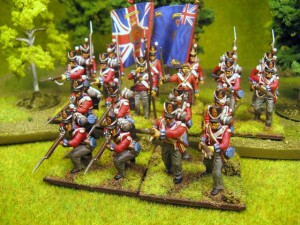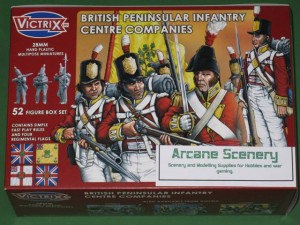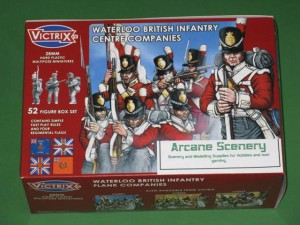 My British Napoleonic army is steadily growing and it has now actually been on the gaming table. Even though I have only finished 40 figures, I was able to join in with a skirmish game that was played at the club that I attend. The skirmish rules were actually written by one of the club members, Richard, and worked really well, allowing us to play with a small force of Napoleonic Infantry rather than the normal large battalions. Basically, we were re-creating the sort of adventure that you read about in Bernard Cornwells’ ‘Sharpe’ novels. So we had a great game, lots of fun and I’m pleased to report that the French Army was prevented from stealing the gold from the Spanish Villagers!
My British Napoleonic army is steadily growing and it has now actually been on the gaming table. Even though I have only finished 40 figures, I was able to join in with a skirmish game that was played at the club that I attend. The skirmish rules were actually written by one of the club members, Richard, and worked really well, allowing us to play with a small force of Napoleonic Infantry rather than the normal large battalions. Basically, we were re-creating the sort of adventure that you read about in Bernard Cornwells’ ‘Sharpe’ novels. So we had a great game, lots of fun and I’m pleased to report that the French Army was prevented from stealing the gold from the Spanish Villagers!
On my last Napoleonic blog posting I said that I would discuss the difference between British Flank & Centre Companies and why there are different sets for Waterloo Infantry & Peninsular War Infantry. Of course if you are a veteran of the hobby you will already know the answers but if like me, you are a newcomer to Napoleonics, these things can be confusing and a barrier to starting your own army. So this is what I’ve discovered and if anyone out there reading this has any extra information or would like to correct any error that I may make, please contact me through my shop email and I will publish your email through the blog. Unfortunately, due to the huge amount of spam that I was getting through the blog, I’ve had to turn off the comments (Thank you to the Russian & American spammers and the Pharmaceutical suppliers that have contributed so far….).
So when deciding what British force that you are going to field, there is one final decision that you need to make. Are you going to model a force from the Peninsular War or do you fancy the period around Waterloo? Or to put the question another way, would you like to have your Line infantry wearing white trousers or grey? Now that’s a gross over simplification that totally ignores the historical perspective but essentially that’s the main difference between the two troop types. If you are desperate to have an army that will fight in Spain & Portugal with all the allies & enemies that go with them, then you need the guys in the white trousers. If you want to fight Waterloo and the associated battles, then grey is for you! There is one other significant difference, the type of hats worn by the officers & troops. In the peninsular, it was the stove pipe shako with the plume at the front for the troops and the Bi-corn Hat for the officers. At Waterloo, the troops wore the Belgiac Shako with the plume to the side and the officers wore the same except that the cord on the front was gold rather than white.
There are some other subtle differences but if you stick to the above, you will be about right. Remember, although the button counters of this world will delight in telling you exactly what shade of underwear the Coldstream Guards were issued with in 1815, we are trying to create an army that looks good on the war games table and in war time troops had a habit of improvising and adapting equipment, even in the 19th century. So you will see troops on campaign wearing a mixture of uniform in different shades and states of wear and tear. If you are happy with that simplification, join me on my next blog article on the construction of my Napoleonic Army and I will start to assemble some figures. Oh! and I’ll get back to you regarding Flank & Centre Companies!



